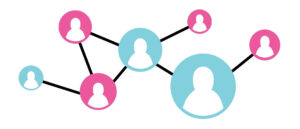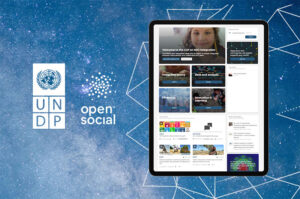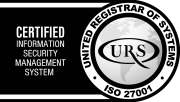For almost 60 years, association communities have always used face-to-face events as their most important communication — continue reading
The changing engagement model of associations: 7 Reasons why an association needs an online community platform
For almost 60 years, association communities have always used face-to-face events as their most important communication platform by far. Now, Covid has caused a digital transformation on steroids and associations are organizing online events at a rapid pace. But this is only part of the answer and only provides a short-term solution.
In the online world, different rules of time and space apply. Continuous interaction is the ‘new normal’, and we won’t go back, even when we can meet face to face again.
As associations play an even more vital role in creating the global talent pool and driving force in societal progress, they need to sustain and facilitate deep and continuous interactions. These interactions are crucial for generating solutions to huge industry problems and stimulating new ways of thinking.
With obvious environmental pressures and the expectations of new generations, the engagement model of associations has changed for good.
Continuous Connections: Online Community First, Events Second
Associations have reaped the benefits and effectiveness of meeting online:
- They reach a larger audience; inclusion
- They are a driver of engagement
- Association members are getting used to online engagement
- Results are very accurately measured
- While costing less than in-person events
However, associations are professional communities. Creating a shared experience (live events; most preferably in person but nowadays also online) is the main key element of building a community. But surely it is not the only one?
In the digital world, associations are continuously connected to their members and stakeholders and members are continuously connected with other members. This means associations have to move away from a scenario in which they only have a temporary, short dialogue with their members into one in which associations are constantly connected with their members, providing service 24/7.
If you think in terms of ‘online community building’ instead of online events you enter a completely different ballgame. Why stick to a 3-day conference online? How counterproductive is it that a virtual event platform closes weeks after the event took place, removing all knowledge and content, established connections and engagement?
But on the other hand: How do you foster and cultivate an online community? How do you create trust, a sense of belonging and engagement online? How do you continuously share resources and knowledge, 365 days a year?
The real driver of value for associations is empowering people to become part of a community in which they feel they belong and that they trust, a community in which they can share knowledge and identify solutions. Many associations already have these communities offline, so the main challenge is how to cultivate them online.
Why outsourcing your association’s engagement to Big Tech is a big mistake
There is a big concern about the effect of Big Tech on our lives. Social media platforms like Facebook and LinkedIn are designed for harvesting your data and selling you ads instead of effectively building your community. Here’s why outsourcing your association’s engagement to Big Tech is a big mistake:
- Privacy: The personal data of your members are not safe and you cannot use it to offer a personalized service
- Sales models: Users are a commodity, sold to the highest bidder
- Algorithmic bubbles increased polarization
- Customization is strictly limited
- There is no integration with your existing tools
- Members use these tools for wider business and personal matters – which means your association is not put at the center and that you risk being ignored.
- You are relying on a third-party platform: They can change their policies, features, business model, content moderation process, or user-interface at any point without warning or consultation.
Even before COVID, there was a growing trend towards smaller communities or private niche interest groups, where smaller groups of people engage on very specific topics dear to them. Harvard Business Review calls this rising trend a shift away from public social media towards ‘digital campfires’.
When community building is your core business, you need to be in control. You need to own the continuous conversation and create your own safe and trusted digital space to thrive.

Here are the 7 reasons why associations need to use their own online community platform
1. Empower your members to share under your flag.
Power your “brand presence strategy” and bring your members together online in your own secure, trusted and branded environment where you can instantly connect member expertise and knowledge related to your niche, year-round, always and everywhere.
2. Increase member engagement with your organization.
Having your own platform allows you to win the “fight for attention” through:
- Creating a dialogue with- and between your members instead of only sending out top-down information.
- Having less irrelevant distractions and clutter.
- Personalization: Personalization is one of the major marketing trends in the coming decade. As you own the platform and the data, members will be more willing to share their personal data, allowing you to offer them a more relevant and personal experience based on their behavior in your community.
- Gamification: Reward your community members for engagement that is valuable for your organization’s mission.
- Inclusion: All your members can join how, when and from where they wish to.
- Effective and self-sufficient support: Moderate and offer guidance to keep your community engaged and growing.
- Becoming a reliable source of filtered and relevant information.
- Creating an on-going conversation before, during and after your (online-) events by providing continuous connections, networking and engagement, while also increasing the value of your event content by offering it on-demand.
3. Increase member collaboration and value creation.
Facilitate and amplify human relationships with year-round member connections “in your pocket” and create added value with purpose-built tools for content creation and real-time collaboration. Trigger members with relevant content and contacts and reward them for their participation.
4. Boost your digital transformation.
Turn your community platform into a central hub by integrating it with your website, CRM, member portal, finance- and event management systems for a centralized, streamlined and personalized user experience.
5. Increase member retention and growth.
Identify member needs and wants through ongoing conversations and use this feedback to update your services. Generate leads by profiling your organization as a thought leader, using social proof, content- and word of mouth marketing as well as Search Engine Optimization.
6. Use the platform to facilitate new ways to monetize your community and change your business- and membership (-subscription) model.
Become less reliant on face-to-face meetings only and offer year-round sponsorship exposure beyond online events.
-
- Integrate (paid) e-learning modules for your certifications, continued education, or training as membership benefits.
- Add new, high-traffic advertising space.
- Promote and sell relevant publications and subscriptions.
- Increase event registration and participation.
7. Last, but not least: More effectively contribute to your organization’s mission with an engagement platform designed to maximize community building and create a natural pool of advocates and volunteers instead of merely collecting data and selling (other people’s) ads.
When community building is your core business, you cannot afford not to create a safe home for your community to thrive. You need to use the digital world to stay relevant, appeal to the next generation of members and continue to establish yourself as an industry leader.
It requires additional engagement, and while only the active members will join at first, these key individuals (or ambassadors) will be the first to set an online culture of sharing, trust and respect, which will help you drive organic growth for your online community.
Yes, in-person meetings will remain the primary community builder, but online (and hybrid) events, as well as online communities, are here to stay. Associations have to keep up with this digital transformation.
After all, it’s not just association meetings that change the world — it’s association communities.
In the end, engaged online communities will most likely increase the attendance and effectiveness of the in-person meetings that we have been missing out on for so long!
Open Social: Purpose-driven platforms
Through my recent blog post, I got in touch with Open Social. This SaaS company specializing in open source community engagement platforms has reached amazing results with online communities created for major mission-driven organizations including the United Nations, Greenpeace, BIO, the International AIDS Society and Salvation Army.
Open Social focuses on organizations that have a positive societal impact. “Open source” means that they use software by the community, for the community. If you work with Open Social, the project itself is benefiting society as investments in new developments are shared with a wider open source community as well as all current Open Social platform users and clients. This is why ever more major organizations join the Open Social family, including most recently: the European Commission (more on this coming soon!).
But being open source also means Open Social:
- Operates at a much faster pace of innovation
- Benefits from more quality control and security
- Offers a wider range of extensions and functionality
This is all because of the large open source Drupal community (as well as other open source communities) who contribute code, help with bug reporting and documentation and develop new tools and innovations. Investments by large partners like the UNDP and the European Commission create a synergy and network effect that is lacking in proprietary software. As an association, you want to make sure that these projects are implemented fast, at low risk and remain flexible enough to try out new business and membership models. Open Social allows you to be agile while making sure that you are 100% GDPR proof and you remain the owner of your platform and user data. Listen to Open Social’s Founder, Taco Potze, making a case for using open source software to create more ethical online communities in this podcast.
If you are a small organization and have the IT expertise to set up your own Open Social community, you can easily deploy the free open source version of Open Social. There are more than a thousand organizations that have done that. You can always call on Open Social for their value-adding Extensions if you need more specialized features for your online community.
Open Social also provides a paid SaaS (Software-as-a-Service) version, for a small monthly fee, including dozens of available extensions such as Zoom or BigBlueButton integration so you can organize virtual events on the platform itself. There are also tools for Crowd Innovation, integrated e-Learning Extensions (ideal for association certification programs), live chat, Gamification elements like quizzing and exciting new blockchain integration to reward your members for their engagements and to see who your super-users are.
To underline its major potential, they received substantial investment in 2020 from Peak Capital and Nimbus Ventures.
Read up on these Open Social case studies to find out more and learn why clients reward Open Social’s team with an average NPS mean score of 9.1:
- Digital Transformation United Nations – Connecting experts with Sparkblue: https://www.getopensocial.com/stories/spark-blue/
- Global action by 60,000 members – Environmental activism with Greenpeace Greenwire: https://www.getopensocial.com/stories/greenpeace-greenwire/
- Connecting Experts during a Crisis – COVID-19 response with BIO Coronavirus Hub: https://www.getopensocial.com/stories/bio-coronavirus-hub/
- A global community for sustainability – Bringing volunteers together with Global Commons: https://www.getopensocial.com/stories/pachamama-alliance/
- Publically crowd-source solutions – Foreign policies challenges by Policy Kitchen: https://www.getopensocial.com/stories/policy-kitchen/
- Connect students and alumni – An online community for Holmesglen Institute: https://www.getopensocial.com/stories/holmesglen/
- Creating Pathways for Sustainable Development – Member Engagement Platform for SDG Philanthropy: https://www.getopensocial.com/stories/sdg-philanthropy/

Please feel free to contact us to request a demo or set up a free trial version.
My new role at Open Social
Long before the “shit hit the fan” in 2020, I believed very strongly in the power of online communities and later the potential of online community platforms for associations. Open Social helps many major organizations with a mission thrive and I am convinced plenty other associations can benefit from this as well – especially now.
Having been at the heart of professional community building in the international association meetings industry at ICCA for almost 20 years, I am really looking forward to contributing to the digital transformation of community building at Open Social as a Strategic Consultant.
You can expect more posts, case studies and thoughts on specific strategies on online community building for associations (and CVBs!) soon. Watch this space! 😉
We need your input!
We are looking for a couple of association volunteers to join an Association User group to jointly discuss needs and opportunities. If you are interested, please do not hesitate to reach out!
I would like to thank the #opensocialfamily for their warm welcome.
#madetoshare

